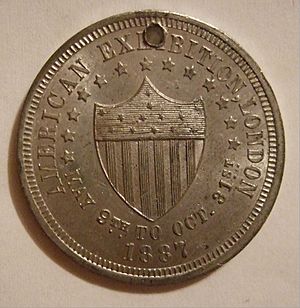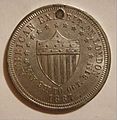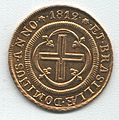Coinage metal facts for kids
Coinage metals are special metals used to make coins. These are usually metals that have been used for a long time to create money. While some metals might seem good for coins, they aren't always used. This is because coins need to be strong and not too valuable on their own. In recent times, countries prefer to use cheaper, more common metals for their coins.
Contents
The History of Coin Metals
For thousands of years, most coins were made from three main metals: copper, silver, and gold. These metals come from a special group on the periodic table called "group 11." Often, copper was mixed with tin and other metals to make bronze. Gold, silver, and bronze were the main coin metals in ancient times and through the Middle Ages.
The idea of coins started around 700 BC. Since then, coins have been a very common way to represent money. The very first coins were made from electrum. This is a natural mix of gold and silver. It's a pale yellow color. Sometimes, more silver and copper were added to electrum.
Even today, valuable metals are used for special coins. These are often called bullion coins. They are usually bought by collectors or investors. They are not meant for everyday shopping.
What Makes a Good Coin Metal?
Coins that we use every day need to be very tough. They might stay in use for up to 30 years! This means they must be very strong and not rust or wear out easily. To achieve this, coins are often made from alloys, which are mixtures of different metals.
Some metals, like manganese, have been tried in coins. But they can make the coins too hard. This makes it difficult to stamp the designs onto them. It can also wear out the machines at the mint.
Why Coin Metal Value Matters
Sometimes, the metal inside a coin can be worth more than the coin's face value. This can cause a problem! People might melt the coins down to sell the metal. For example, old British pennies were mostly copper. By 2008, the copper in one of these pennies was worth more than the coin itself! Because of this, modern British pennies are now made of copper-plated steel. American pennies also changed from copper to copper-plated zinc for the same reason.
This problem has led to changes in coin making. A common metal mix called cupronickel used to be popular. It's usually 75% copper and 25% nickel. Cupronickel looks silver, is very strong, and takes designs well. But as copper and nickel prices went up, countries started looking for cheaper options.
In the 21st century, many countries are trying different types of steel. Often, they use stainless steel. For example, some coins in India are made from stainless steel. This steel contains mostly iron and chromium. Many other countries are also testing steel alloys to keep the cost of making coins low.
Chemical Elements Used in Coins
Here are some of the chemical elements that have been used in coins for everyday use:
- Aluminium (First used in 1907 for coins in East Africa and Uganda)
- Antimony (Used in a Chinese coin in 1931)
- Carbon (Found in all steel and iron coins)
- Chromium (Used to plate coins and in some strong stainless steel coins)
- Copper
- Gold
- Iron
- Lead
- Manganese
- Magnesium (Used in magnesium-aluminum coins in Poland in 1943, and in India)
- Nickel (Used in metal mixes for a long time. The first pure nickel coin was made in Switzerland in 1881)
- Platinum (Used in Russian coins between 1828 and 1845)
- Silver
- Tin
- Zinc
Images for kids
-
A 1950 iron Swedish krona coin, with a value of 5 öre
-
A silver drachma coin from the island of Aegina, made after 404 BC







